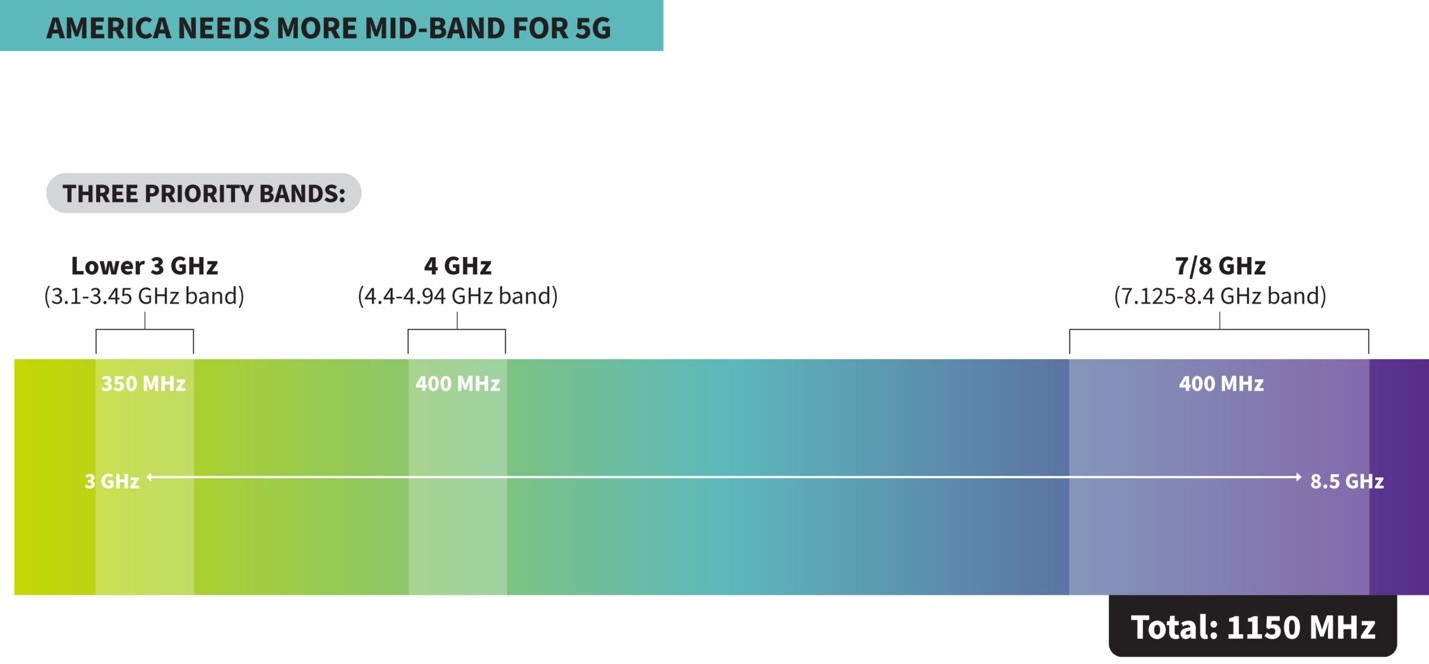By 2027, 5G is projected to account for 90% of all mobile subscriptions in North America, compared to 20% in 2021 [i]. However, according to a new Accenture study commissioned by CTIA, additional spectrum, particularly in the mid-band range, is going to be critical to ensuring a successful rollout and making sure the promised benefits of 5G come true for American consumers.
If the relative imbalances in spectrum allocation are not addressed with more licensed spectrum made available to commercial wireless providers, consumers, businesses, and public services will bear the burden of the expected network strain. Diminished quality and availability of services will prevent the full promise of 5G use cases which are poised to transform the economy.
Why spectrum matters
Consumer mobile data usage continues to grow at a stunning rate; as of June 2022, the average monthly mobile data usage per smartphone in North America was around 15GB and is projected to hit 52GB in 2027 - representing a compound annual growth rate (CAGR) of 24% [ii]. This data usage will only continue to grow as 5G supports a wealth of new use cases for all users.
5G will enable a myriad of connected devices (up to 100x more than 4G) and technological applications (able to transmit data at up to 100x the speed of 4G), but it will rely heavily on the availability of spectrum [iii]. It will require high-band spectrum to support more devices and high data throughput in dense urban areas as well as mid-band spectrum to provide a mix of geographic coverage and data throughput [iv] [v]. Simultaneously, low-band spectrum will be required as a 5G coverage layer in addition to supporting and sustaining existing wireless use cases and prior generations of technology (e.g., 4G), which currently provide coverage to 99.9% of Americans [vi].
The CTIA study, titled Spectrum Allocation in the United States, assesses the current state of spectrum allocation in the US and makes it clear that imbalances in allocations could hinder the ability of wireless networks to keep up with projected growth and increased demand. In the lower mid-band, defined for the purposes of this study as the range of radio frequencies between 3 to 8.4 GHz, the commercial wireless industry currently has access to only 5% of spectrum. By comparison, unlicensed spectrum users have access to over 7x that amount (~36%), while government stakeholders have access to over 12x the amount of spectrum (~61%). This relative imbalance is particularly problematic given that the lower mid-band is essential for supporting the type and amount of new data traffic associated with 5G services due to its ability to satisfy both coverage and capacity requirements.
Additional licensed spectrum has been made available to the commercial wireless industry over the past two years. For example, the 3.45 GHz band, the C-band, and the CBRS band collectively made 270 MHz available to the commercial wireless industry, with an additional 180 MHz expected by the end of 2023. Despite this recent progress, further access to wide, contiguous spectrum is necessary to bring global harmonization, limit the costs of infrastructure deployment, and ensure continued efficient use of already-allocated commercial wireless spectrum.
The path to 5G
The study finds that the following three blocks of lower mid-band spectrum offer the greatest potential for 5G expansion.

- 350 MHz in the 3.1-4.5 GHz band: The lower 3 GHz band offers reliable coverage and adequate range of coverage, making it ideal for 5G data traffic. This band is adjacent to the recently auctioned 3.45 GHz band, which would help drive lower costs for device manufacturers when developing products for a wider contiguous band.
- 400 MHz in the 4.4-4.94 GHz band: The mid 4 GHz band is a wide contiguous block of spectrum that provides high capacity for 5G networks. It has been allocated to wireless carriers in many other nations, meaning a similar allocation in the US would support international harmonization efforts yielding cost benefits.
- 400 MHz in the 7.125-8.4 GHz band: The 7 to 8.4 GHz range is a significant block of higher frequency contiguous spectrum. The capacity characteristics of this range make it ideal for serving densely populated areas such as urban centers, where traffic requirements are greater.
Allocating these three bands for commercial wireless use would result inunlicensed users havingaccess to 1.19x and government users having access to 1.34x the amount of spectrum as commercial wireless users.
The time to act is now
5G is expected to bring greater capacity, lower latency and faster speeds. However, more licensed mid-band spectrum is needed to meet growing wireless network demand because it delivers the right blend of capacity and range. Commercial access to the bands described above would help scale 5G and give more people access to consistent and good internet connectivity needed for emerging bandwidth-intensive applications.
Gaining access to this spectrum will be critical for the US to maintain and secure its leadership of the emerging 5G economy. Doing so will enable commercial wireless providers to fully meet the significant demand increase while ensuring a low cost to consumers.
Sources:
[i] "Ericsson Mobility Report". Ericsson, June 2022. Retrieved from https://www.ericsson.com/49d3a0/assets/local/reports-papers/mobility- report/documents/2022/ericsson-mobility-report-june-2022.pdf
[ii] "Ericsson Mobility Report". Ericsson, June 2022. Retrieved from https://www.ericsson.com/49d3a0/assets/local/reports-papers/mobility- report/documents/2022/ericsson-mobility-report-june-2022.pdf
[iii] "Spectrum Policy”. CTIA, 2022. Retrieved from https://www.ctia.org/spectrum#:~:text=5G.,and%20drive%20more%20data%20use
[iv] Davis, Riley. "What Is Spectrum? A Brief Explainer". CTIA, June 5, 2018. https://www.ctia.org/news/what-is-spectrum-a-brief-explainer
[v] "The Electromagnetic Spectrum". Ofcom. Retrieved from https://www.ofcom.org.uk/__data/assets/image/0026/194318/electromagnetic-spectrum.png
[vi] "Spectrum Channel". CTIA, 2022. Retrieved from https://www.ctia.org/spectrum-channel




















